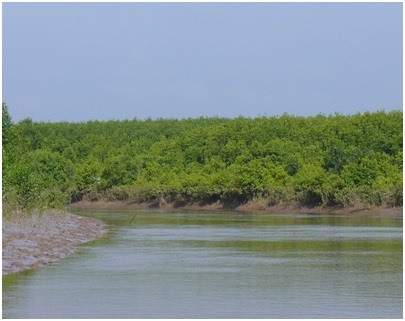Tra Vinh (VNS/VNA) -Farmers in Tra Vinh province’s coastal areas expanded the breeding of shrimpand other aquatic species to an additional 1,700ha of mangrove forests this year,according to the provincial Department of Agriculture and Rural Development.
The breeding in mangroveforests, which now totals 5,780ha, is sustainable and protects the environmentagainst the effects of climate change, said the department.
Farmers only need to buy shrimpand fries for breeding since the aquatic species eat wild food in the forests.
Farmers normally breed shrimpwith a density of 15-20 shrimp per sq.m in mangrove forests.
Duyen Hai district has about5,100ha of mangrove forests used for breeding aquatic species, the province’slargest area, according to the district’s Division of Agriculture and RuralDevelopment.
Ngo Oanh Ruong, who has aone-ha mangrove forest in Duyen Hai district’s Dong Hai commune, breeds about20,000 black-tiger shrimp and 3,000 mud crabs in his forest every year.
Last year, he harvested 500kilogramme of black-tiger shrimp and earned a profit of 150 million VND (6,450USD) from the shrimp. The model yields high profits and protects theenvironment, he said.
Lam Thanh Nam, who hasimplemented the model on 4ha in Duyen Hai town’s Hiep Thanh commune for nearly10 years, said he had planted mangrove species like black mangrove, greymangrove and spotted mangrove to provide shade for shrimp and other aquaticspecies.
He breeds shrimp and mud crabsin the forest and earns a high income from the model every year.
Pham Minh Truyen, Deputy Directorof the provincial Department of Agriculture and Rural Development, said thatbreeding shrimp under an industrial farming model provides high profits butrequires high investment costs.
Farmers who do not have enoughcapital to invest in industrial shrimp farming can more easily become involvedin the mangrove-forest model, he said.
Shrimp bred under the model areconsidered organic. Besides shrimp, other aquatic species like mud clams, bloodcockles, eels and frogs are commonly bred in mangrove forests.
The department is promotingorganic shrimp supply chains to help farmers increase income and maintain themangrove forests for breeding of aquatic species.
Local authorities haveencouraged farmers to grow mangrove forests and breed shrimp and other aquaticspecies because of it lessens disease outbreaks and is environmentallyfriendly.
With a coast of 65km, theMekong Delta province has great potential to develop the mangrove shrimpbreeding model.
The province has about 9,000haof forests, mostly in Chau Thanh, Cau Ngang and Duyen Hai districts and DuyenHai town, according to the department.-VNS/VNA




























